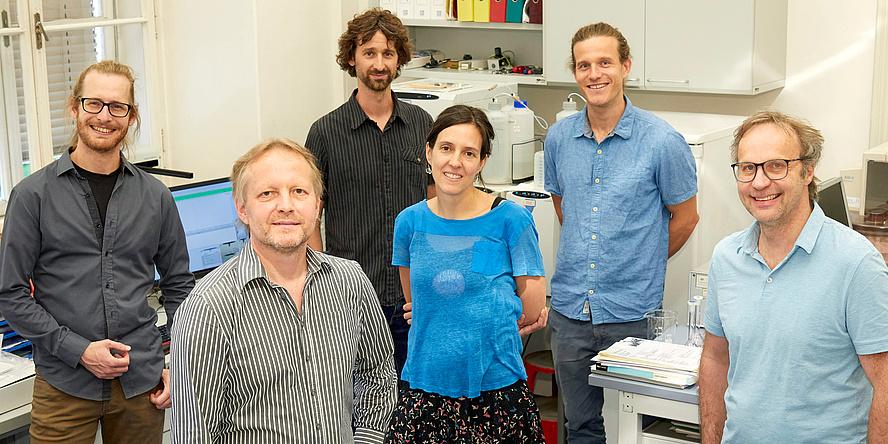Jun 29 2020
Be it porous bridge piers, collapsing tunnel walls, or cracks in concrete facades, damage caused to concrete structures by numerous environmental impacts cost several billion euros globally per annum, reveal statistics from the National Association of Corrosion Engineers (NACE).
 Cross-institute work at TU Graz on new investigation methods for concrete structures: Bernhard Müller (Institute of Analytical Chemistry and Food Chemistry), Martin Dietzel (head of the Institute for Applied Geosciences), Florian Mittermayr (Institute of Technology and Testing of Construction Materials), Isabel Galan Garcia and Cyrill Grengg (both Institute of Applied Geosciences), Torsten Mayr (Institute of Analytical Chemistry and Food Chemistry). Image Credit: © Melbinger—TU Graz.
Cross-institute work at TU Graz on new investigation methods for concrete structures: Bernhard Müller (Institute of Analytical Chemistry and Food Chemistry), Martin Dietzel (head of the Institute for Applied Geosciences), Florian Mittermayr (Institute of Technology and Testing of Construction Materials), Isabel Galan Garcia and Cyrill Grengg (both Institute of Applied Geosciences), Torsten Mayr (Institute of Analytical Chemistry and Food Chemistry). Image Credit: © Melbinger—TU Graz.
In close collaboration with the Austrian Society for Construction Technology (ÖBV), scientists from Graz University of Technology (TU Graz) are aiming to provide a solution to this global economic issue.
As part of the LumAConM (high-resolution luminescent analyses of construction materials) project, the group is exploring a new, easy, and economical technique that allows a comprehensive evaluation of the state of concrete structures on-site and also laboratory measurements with unparalleled accuracy.
This makes it possible to assess the service life and any problem areas much more rapidly and accurately than is possible with existing methods of analysis.
Moreover, the team believes that the new technique will give them a deeper insight into the course of necessary corrosion processes.
This knowledge enables targeted and cost-effective refurbishment and is essential for the development of new, sustainable and durable materials.
Florian Mittermayr, Researcher, Institute of Technology and Testing of Construction Materials, Graz University of Technology
Innovative Sensor Material as Basis
The basis of the novel process is optical-chemical sensor technology. Until now, this highly sophisticated, optical measurement analysis has been mainly employed in medical technology and biotechnology.
We now want to use the tool to assess the condition of concrete infrastructure and thus develop a completely new generation of sensors for the construction industry.
Bernhard Müller, Chemist, Institute of Analytical Chemistry and Food Chemistry, Graz University of Technology
One example of this is an imaging measurement system that has been adopted at TU Graz to quantitatively determine the pH value in materials based on cement—a parameter that generally corresponds directly with corrosion damage.
The measuring system features a plastic film with a swellable (that is, water-absorbent) polymer layer comprising a reference dye and an indicator dye. The dimension of the sensor foil size can be adjusted to the size of the sample being analyzed.
After applying the wet film to the sample, the pH distribution images are subsequently produced with the help of a unique camera. This method was already able to detect the pH value changes in numerous building materials very precisely and define corrosion damage in more detail.
The measurement system employed in the LumAConM project is to be further improved by the end of 2022 and is expected to lead to multipurpose measurement technology.
Extensive Application Possibilities
By contrast, scientists prefer to extend the measuring system to involve other parameters such as chloride. For the first time, this would allow the combined determination of pH and chloride concentration directly on-site at concrete structures.
For instance, chloride attacks, caused by road salt in winter, present a major risk of corrosion for concrete structures (particularly for bridges) and are one of the most common causes of corrosion across the world.
However, the sensor material that has been designed for the films also needs to be converted to other sensor formats. For non-uniform concrete surfaces, for which the films are not appropriate, the researchers would prefer to employ sprayable sensor particles and therefore render the imaging technology available for the general practice of revealing the underlying structures on site.
The condition is currently evaluated through core sampling as well as complex chloride determination using chloride titration. Furthermore, the team plans to create tiny optical fiber-based probes. This would not only allow the researchers to take measurements on the concrete surface but would also allow them to create depth profiles easily using drill holes.
I think that in the medium to long term, the procedure can replace other, more expensive and more complex investigation methods to a large extent and make quality management in concrete construction much easier.
Cyrill Grengg, Institute of Applied Geosciences, Graz University of Technology
Grengg confirmed the high prospects of the measurement technology.